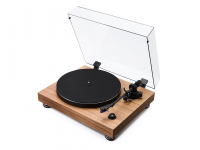We’ve been bombarded by streaming speakers in the last couple of years. Read why the Bluetone 100 is one to go for.
Bluetooth’s rise in audio-industry terms, has been positively stratospheric. These days, you can’t move for mention of Bluetooth from all and sundry. Wireless connectivity was always going to be an attractive proposition for the masses, and the quick and easy setup of Bluetooth-enabled products was a god-send for those less tech-savvy. Doing away with problematic physical connections from devices like mobile phones – that are replaced almost yearly now – meant far fewer connectivity problems between both new and old devices alike. Not without it’s own quality issues initially, advances in Bluetooth technology have now seen even the oldest of Hi-Fi manufacturers regard it as a real player in achieving great sound as easily as possible. Today, we’ll be looking at Cambridge Audio’s latest dedicated Bluetooth effort – the Bluetone 100.
Based around their older ‘Air 100‘, Cambridge have stripped things back for this new release. As mentioned above, Bluetooth has come on a long way recently, particularly with the arrival of AptX, an innovation that increases the bandwidth available for music playback – a huge boon to sound quality. A set of 3.5mm and RCA jacks are still provided, but gone are the Airplay and Internet radio connectivity seen on the previous model. The loss of these two features causes no real concern, as the Bluetone is capable of receiving Internet radio directly from your smart phone, as well as services such as Spotify, BBC iPlayer radio and others. The tasty price-drop that their exit brings is a guaranteed crowd pleaser.
Hardware wise, the Bluetone 100 is the mirror image of its predecessor. The years have been kind to its soft curves, looking sleek and modern still today. The matte coat of paint is again one of my favourite changes, following suit from the Cambridge Go V2. Unlike its smaller brother, the Bluetone is not battery operated, so is less likely to be moved about, but it’s now fairly fingerprint-resistant, and this is never a bad thing. The ability to remember up to 8 devices is also a huge plus, meaning the whole family can get in on the action without constant re-searching when connecting.
Power output is a very respectable 100 watts (thus the name!) and some clever on-board signal processing means that, typical of the brand, it’s obvious that sound quality is of paramount importance. Far too many designers of this type of product try to get away with underpowered speakers, driven by cheap, digital amplifiers – not so the Bluetone. Coupled with their favoured BMR drivers, the corners that others dare to cut are handled deftly and correctly by the London-based firm. Analogies over, time for a listen!
Female vocal tracks are often cited as a great way to test out a speaker’s mid-range, right through to its high frequencies. If it’s a fairly modern recording, there is also a decent chance that a fair amount of compression could be lumbered onto the song too, making this a difficult test to pass. Feeling slightly sinister, I thought I’d throw the Bluetone right in at the deep end. Adele’s multi-Grammy winning ‘21‘ is about as well recognised an album as you’ll find from the past ten years, and the CD version of it is unfortunately quite heavily compressed. Ripped to my phone in ALAC and with Bluetooth switched on, I feared the worst. It’s not the poorest recording ever, but the compression is noticeable, and it can get harsh in places. ‘Set Fire to the Rain’ was the first track played, and my fears were allayed. The piano intro that has scored a thousand X-Factor VT’s, sounded light and clear, but there was weight and body to it, too. Adele’s fantastic, full tone was delivered with gusto in the chorus, and the energy was palpable, with plenty of depth to the bottom end, and the top kept in check also.
Loading up TuneIn, I fired up the excellent Deep Vibes Radio. Broadcast from (I imagine!) somebody’s bedroom in London (the London bit is right, anyway!), DVR plays some of the funkiest House music around. What’s more, they offer it up in anything from 64kb up to 320kb MP3, running the range of encoding from poor to excellent quality. The 64kb wasn’t bad, but the sound lost a bit of its dynamism, flattening slightly in the process. Worried that this was possibly in part down to the Bluetone, I switched up through my settings and found a good jump in quality each time. The worse the signal in, the worse the signal out, but even at it’s flattest, the Bluetone kept bouncing along to the tuneful bleeps and 4/4 beats. Cranking the volume increased foot-tapping and that’s what a music fan wants.
It wasn’t completely flawless. There isn’t much in the way of a soundstage, despite it’s curved front, the sound clearly comes from it’s limited frontage, and not from around. However, I’ve yet to find a similar product that manages this trick, normally reserved for separate speakers – certainly no other that I’ve heard at the price point have pulled it off, so it’s not a huge strike against. Some may prefer a slightly brighter presentation also, at times – but this too means that it’s a more rounded and forgiving listen when dealing with compressed music.
It’s full-bodied in it’s presentation, firm in it’s grip of a beat, and in trimming the fat off it’s predecessor, comes in at a more pleasing price tag. A year of successes continues for Cambridge, then.
Shop for Cambridge Audio with Richer Sounds.
Author: Chris, Liverpool store








